#Children and Family Counseling Associates
Text
Let’s Talk About It... - August 29th, 2022
In our culture there are topics that people often find difficult to talk about. Parents could certainly make a list of the difficult topics they struggle to know how to broach. There is even some concern that by talking about difficult topics that we are planting a seed or the idea and that could in some way be harmful to our children. While it is important to always consider a child’s age and developmental level, it is equally important to educate and communicate with our youth, even when the topic up for discussion is difficult. In this blog, I will discuss suicide prevention measures and why it is so important. Suicide is the second leading cause of death for our youth. According to the National Alliance on Mental Illness, nearly 20% of high-school students report serious thoughts of suicide and as many as 9% have made an attempt. Adolescents are vulnerable for many reasons, including their developmental level and social stressors.
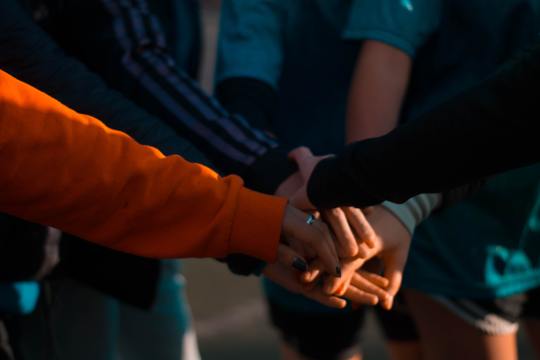
Because teens are often influenced by other teens it is important to teach young people how to recognize warning signs (clues) that a person considering suicide may display. The following list provides examples of warning signs that our youth should be able to recognize:
Loss of interest/pleasure in activities
Giving away possessions
Dropping hints/clues that you may not be here very much longer
Expressing desire to die or not be a burden to others
Expressing feelings of sadness, hopelessness, or having no reasons to live
Suicidal behaviors that may include making a plan and/or doing something in preparation of ending one’s life
Change in behaviors, such as being risky
Using drugs or alcohol
Situational Clues – change in living situation, lose a job, failing in school, break-up, parents are divorcing, etc.
Equally important is helping youth know how to respond if they begin to pick up on ‘clues’ from their friends. If you recognize warning signs it is important that you TALK ABOUT IT. Asking someone if they are contemplating ending their life will NOT harm the person. If you cannot find the words and feel too uncomfortable then find someone else to ask. How you ask doesn’t matter, what matters is that you ASK.

Teaching your teen about the prevalence of suicide and how to respond if they or someone they care about is considering ending their life could be a LIFE-SAVING LESSON. Reminding teens that problems are temporary and can be solved, no matter how difficult they may seem can give teens HOPE. Talking about difficult topics, like Teen Suicide can give youth the tools they need to preserve LIFE.

Staci Holderman, MA, LPCC-S
#Children and Family Counseling Associates Inc#Children and Family Counseling Associates#Children and Family Counseling Associates Inc.#cafca#CAFCA Inc#CAFCA Inc.#Staci Holderman#mental health#mental health support#mental health resource#mental health awareness#suicide prevention#suicide awareness#National Suicide Prevention#teens#teenager#Teenagers#adolescent#Harrodsburg#Kentucky#august#2022
2 notes
·
View notes
Text
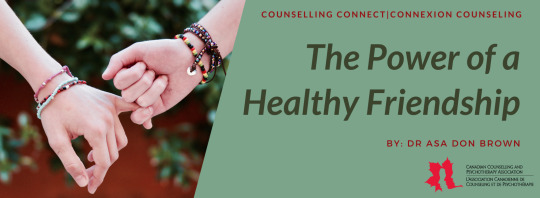
THE POWER OF A HEALTHY FRIENDSHIP
Published with: Canadian Counselling and Psychotherapy Association
Dr. Asa Don Brown http://asadonbrown.com
https://www.ccpa-accp.ca/the-power-of-a-healthy-friendship/
Canadian Counselling and Psychotherapy Association, Counselling Connect, CCPA

#healthy#emotional health#physical health#health#mental health#healthy friendships#friendship#friends#interpersonal relationships#relationship#couples#families#family#best friend#psychology#counseling#counselling#children#canadian counselling and psychotherapy association#psychotherapy#canada#narcissistic abuse#substance abuse#domestic abuse#abuse#asa don brown
1 note
·
View note
Text
since we now know that all those "my blog is safe for Jewish people" posts are bullshit, here are some Jewish organizations you can donate to if you actually want to prove you support Jews. put up or shut up
FIGHTING HUNGER
Masbia - Kosher soup kitchens in New York
MAZON - Practices and promotes a multifaceted approach to hunger relief, recognizing the importance of responding to hungry peoples' immediate need for nutrition and sustenance while also working to advance long-term solutions
Tomchei Shabbos - Provides food and other supplies so that poor Jews can celebrate the Sabbath and the Jewish holidays
FINANCIAL AID
Ahavas Yisrael - Providing aid for low-income Jews in Baltimore
Hebrew Free Loan Society - Provides interest-free loans to low-income Jews in New York and more
GLOBAL AID
American Jewish Joint Distribution Committee - Offers aid to Jewish populations in Central and Eastern Europe as well as in the Middle East through a network of social and community assistance programs. In addition, the JDC contributes millions of dollars in disaster relief and development assistance to non-Jewish communities
American Jewish World Service - Fighting poverty and advancing human rights around the world
Hebrew Immigrant Aid Society - Providing aid to immigrants and refugees around the world
Jewish World Watch - Dedicated to fighting genocides around the world
MEDICAL AID
Sharsheret - Support for cancer patients, especially breast cancer
SOCIAL SERVICES
The Aleph Institute - Provides support and supplies for Jews in prison and their families, and helps Jewish convicts reintegrate into society
Bet Tzedek - Free legal services in LA
Bikur Cholim - Providing support including kosher food for Jews who have been hospitalized in the US, Australia, Canada, Brazil, and Israel
Blue Card Fund - Critical aid for holocaust survivors
Chai Lifeline - An org that's very close to my heart. They help families with members with disabilities in Baltimore
Chana - Support network for Jews in Baltimore facing domestic violence, sexual abuse, and elder abuse
Community Alliance for Jewish-Affiliated Cemetaries - Care of abandoned and at-risk Jewish cemetaries
Crown Heights Central Jewish Community Council - Provides services to community residents including assistance to the elderly, housing, employment and job training, youth services, and a food bank
Hands On Tzedakah - Supports essential safety-net programs addressing hunger, poverty, health care and disaster relief, as well as scholarship support to students in need
Hebrew Free Burial Association
Jewish Board of Family and Children's Services - Programs include early childhood and learning, children and adolescent services, mental health outpatient clinics for teenagers, people living with developmental disabilities, adults living with mental illness, domestic violence and preventive services, housing, Jewish community services, counseling, volunteering, and professional and leadership development
Jewish Caring Network - Providing aid for families facing serious illnesses
Jewish Family Service - Food security, housing stability, mental health counseling, aging care, employment support, refugee resettlement, chaplaincy, and disability services
Jewish Relief Agency - Serving low-income families in Philadelphia
Jewish Social Services Agency - Supporting people’s mental health, helping people with disabilities find meaningful jobs, caring for older adults so they can safely age at home, and offering dignity and comfort to hospice patients
Jewish Women's Foundation Metropolitan Chicago - Aiding Jewish women in Chicago
Metropolitan Council on Jewish Poverty - Crisis intervention and family violence services, housing development funds, food programs, career services, and home services
Misaskim - Jewish death and burial services
Our Place - Mentoring troubled Jewish adolescents and to bring awareness of substance abuse to teens and children
Tiferes Golda - Special education for Jewish girls in Baltimore
Yachad - Support for Jews with disabilities
#atlas entry#please add any more you know of an especially add fundraisers for you or people you know#if there are any fundraisers for synagogues please add those as well#jew#jewish#judaism#jumblr#punch nazis
2K notes
·
View notes
Text
A taxonomy of corporate bullshit
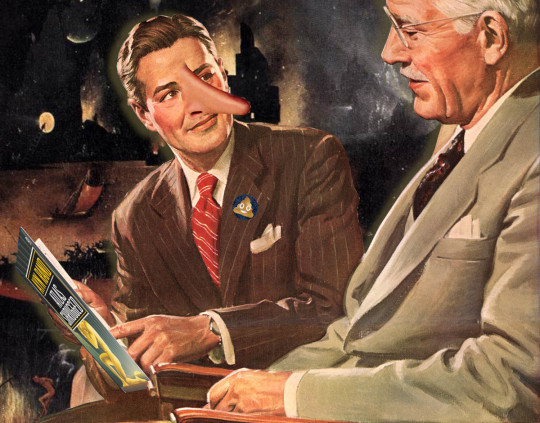
Next Tuesday (Oct 31) at 10hPT, the Internet Archive is livestreaming my presentation on my recent book, The Internet Con.

There are six lies that corporations have told since time immemorial, and Nick Hanauer, Joan Walsh and Donald Cohen's new book Corporate Bullsht: Exposing the Lies and Half-Truths That Protect Profit, Power, and Wealth in America* provides an essential taxonomy of this dirty six:
https://thenewpress.com/books/corporate-bullsht
In his review for The American Prospect, David Dayen summarizes how these six lies "offer a civic-minded, reasonable-sounding justification for positions that in fact are motivated entirely by self-interest":
https://prospect.org/culture/books/2023-10-27-lies-my-corporation-told-me-hanauer-walsh-cohen-review/
I. Pure denial
As far back as the slave trade, corporate apologists and mouthpieces have led by asserting that true things are false, and vice-versa. In 1837, John Calhoun asserted that "Never before has the black race of Central Africa, from the dawn of history to the present day, attained a condition so civilized and so improved, not only physically, but morally and intellectually." George Fitzhugh called enslaved Africans in America "the freest people in the world."
This tactic never went away. Children sent to work in factories are "perfectly happy." Polluted water is "purer than the water that came from the river before we used it." Poor families "don't really exist." Pesticides don't lead to "illness or death." Climate change is "beneficial." Lead "helps guard your health."
II. Markets can solve problems, governments can't
Alan Greenspan made a career out of blithely asserting that markets self-correct. It was only after the world economy imploded in 2008 that he admitted that his doctrine had a "flaw":
https://www.pbs.org/newshour/show/greenspan-admits-flaw-to-congress-predicts-more-economic-problems
No matter how serious a problem is, the market will fix it. In 1973, the US Chamber of Commerce railed against safety regulations, because "safety is good business," and could be left to the market. If unsafe products persist in the market, it's because consumers choose to trade safety off "for a lower price tag" (Chamber spox Laurence Kraus). Racism can't be corrected with anti-discrimination laws. It's only when "the market" realizes that racism is bad for business that it will finally be abolished.
III. Consumers and workers are to blame
In 1946, the National Coal Association blamed rampant deaths and maimings in the country's coal-mines on "carelessness on the part of men." In 2003, the National Restaurant Association sang the same tune, condemning nutritional labels because "there are not good or bad foods. There are good and bad diets." Reagan's interior secretary Donald Hodel counseled personal responsibility to address a thinning ozone layer: "people who don’t stand out in the sun—it doesn’t affect them."
IV. Government cures are always worse than the disease
Lee Iacocca called 1970's Clean Air Act "a threat to the entire American economy and to every person in America." Every labor and consumer protection before and since has been damned as a plague on American jobs and prosperity. The incentive to work can't survive Social Security, welfare or unemployment insurance. Minimum wages kill jobs, etc etc.
V. Helping people only hurts them
Medicare will "destroy private initiative for our aged to protect themselves with insurance" (Republican Senator Milward Simpson, 1965). Covid relief is unfair to people that are currently in the workforce" (Republican Governor Brian Kemp, 2021). Welfare produces "learned helplessness."
VI. Everyone who disagrees with me is a socialist
Grover Cleveland's 2% on top incomes is "communistic warfare against rights of property" (NY Tribune, 1895). "Socialized medicine" will leave "our children and our children’s children [asking] what it once was like in America when men were free" (Reagan, 1961).
Everything is "socialism": anti-child labor laws, Social Security, minimum wages, family and medical leave. Even fascism is socialism! In 1938, the National Association of Manufacturers called labor rights "communism, bolshevism, fascism, and Nazism."
As Dayen says, it's refreshing to see how the right hasn't had an original idea in 150 years, and simply relies on repeating the same nonsense with minor updates. Right wing ideological innovation consists of finding new ways to say, "actually, your boss is right."
The left's great curse is object permanence: the ability to remember things, like the fact that it used to be possible for a worker to support a family of five on a single income, or that the economy once experienced decades of growth with a 90%+ top rate of income tax (other things the left manages to remember: the "intelligence community" are sociopathic monsters, not Trump-slaying heroes).
When the business lobby rails against long-overdue antitrust action against Amazon and Google, object permanence puts it all in perspective. The talking points about this being job-destroying socialism are the same warmed-over nonsense used to defend rail-barons and Rockefeller. "If you don't like it, shop elsewhere," has been the corporate apologist's line since slavery times.
As Dayen says, Corporate Bullshit is a "reference book for conservative debating points, in an attempt to rob them of their rhetorical power." It will be out on Halloween:
https://bookshop.org/a/54985/9781620977514

If you'd like an essay-formatted version of this post to read or share, here's a link to it on pluralistic.net, my surveillance-free, ad-free, tracker-free blog:
https://pluralistic.net/2023/10/27/six-sells/#youre-holding-it-wrong
#pluralistic#corporate bullshit#lies#books#reviews#taxonomies#labor#denialism#consumerism#Nick Hanauer#Joan Walsh#Donald Cohen#history#object permanence#taking the right seriously
835 notes
·
View notes
Text
Dabi:
General backstory given in Chapter 301 and 302 - the specifics of the breakdown of the Todoroki household, how Touya ended up developing Blue Flames, and what led to the inferno at Sekoto Peak.
Then gets one more backstory reveal in Chapter 350 when he reveals to Shouto how he became Dabi - how coming home after three years and seeing the "same old story" of Endeavor's selfishness and abuse was the thing that truly broke him.
Spinner (and Heteromorphs):
General backstory given in Chapter 220 - that heteromorphs are discriminated against, to the point there's anti-heteromorph hate groups; Chapter 233 tells us Spinner was bullied into becoming a shut-in.
Then more details are reveal in Chapters 370-373 - how widespread and entrenched anti-heteromorph sentiments are in the countryside, how heteromorph children are "forced to bear scars"; Spinner tells us a specific thing - he was sprayed with pesticides just for walking outside. Lots of Heteromorphs in general hold a grudge against Heroes for not doing anything about this.
Toga:
General backstory given in Chapter 225 and 226 - she had a quirk that had her instinctively associate affection with blood-drinking, her parents yelled at her and she went through quirk counseling but it didn't work, and later she snapped and stabbed a kid.
Gets more detailed backstory flashbacks in Chapter 391 - the extent of the emotional abuse her parents dealt, the conformity and alienation that quirk counseling forced upon her, and just how inhuman she's felt living on the current world.
In all the above, we have the villain; their backstory pointing to a problem, established in Act II of the story; and as they confront the Hero in a final battle in Act III, a second part to the backstory is revealed - one that shows how the problem is actually worse than previously shown. (To validate the genuineness of the villain's pain and anger at just how Heroes have failed them; final emphasis that the villains really do deserve saving and the Hero is correct for wanting to save them.)
So. Shigaraki:
His general backstory given in Chapter 222 and Chapter 235-237 - the dysfunctions of Shimura family that can be traced back to Nana's decision to pick heroics over family; how Tenko had been repeatedly rejected and ignored by people who should've helped him; the Decay quirk manifesting; and how AFO took advantage of this accumulation of tragedies to groom Tomura into the Symbol of Fear.
All that, but following the possible pattern, I think we might just get one more backstory reveal for Shigaraki, especially given the memory share between him and Deku. A new flashback to his time growing up with AFO.
Place your bets on what it is. Me, I think we'll finally learn why All Might ticks him off so bad.
#shigaraki tomura#Shimura Tenko#spinner#Iguchi Shuuichi#toga himiko#dabi#todoroko touya#bnha#mha#heroaca#nalslastworkingbraincell
103 notes
·
View notes
Text
Madison Pauly and Henry Carnell at Mother Jones:
The conversion therapists met last November at the south end of the Las Vegas Strip. Behind the closed doors and drawn blinds of a Hampton Inn conference room, a middle-aged woman wearing white stockings and a Virgin Mary blue dress issued a call to arms to the 20-some people in attendance. “In our current culture, in which children are being indoctrinated with transgender belief from the moment they’re out of the womb, if we are confronted with a gender-confused child, you must help,” declared Michelle Cretella, a board member of the Alliance for Therapeutic Choice and Scientific Integrity. “We must do something.”
Cretella was delivering a keynote speech at the first in-person conference in four years of the Alliance, which describes itself as a “professional and scientific organization” with “Judeo-Christian values.” Its purpose: to defend and promote the practice of conversion therapy by licensed counselors.
Not that they’d call what they do “conversion therapy.” That term lacks a precise definition, but it is used colloquially to describe attempts to shift a person’s sexual orientation or gender identity. In the 1960s, some psychologists tried to make gay men straight by pairing aversive stimuli, like electric shocks or chemically induced nausea, with images of gay porn—techniques that ran the risk of causing serious psychological damage even as they failed to change participants’ sexual orientation, researchers eventually concluded. Today, “conversion therapy” generally takes the form of verbal counseling. Participants are typically conservative Christians who engage voluntarily—motivated by internalized stigma, family pressure, and the belief that their feelings are incompatible with their faith. Others are children, brought into therapy by their parents.
The American Psychological Association (APA) has concluded that conversion therapy lacks “sufficient bases in scientific principles” and that people who have undergone it are “significantly more likely to experience suicidality and depression.” Similarly, the Substance Abuse and Mental Health Services Administration (SAMHSA), part of the Department of Health and Human Services, published a report concluding that “none of the existing research supports the premise that mental or behavioral health interventions can alter gender identity or sexual orientation. Interventions aimed at a fixed outcome, such as gender conformity or heterosexual orientation…are coercive, can be harmful, and should not be part of behavioral health treatment.”
Accordingly, the Alliance and the ideas it promotes have been relegated to the scientific and political fringes. In the 2010s, as acceptance of gay rights grew rapidly, 18 states and dozens of local governments passed laws forbidding mental health professionals from attempting conversion therapy on minors.
Yet by 2020, a new front had opened in the war against LGBTQ people. Republican state legislatures started passing laws targeting transgender and nonbinary children at school—restricting their access to bathrooms, barring them from participating in sports, and stopping educators from teaching about sexual orientation or gender identity. The most intense attacks have banned doctors from providing the treatments for gender dysphoria backed by all major US medical associations. Nearly 114,000 trans youth live in states where access to puberty blockers and hormone therapy has been wiped out.
Last year, I received leaked emails illustrating how these laws are crafted and pushed by a network of anti-trans activists and powerful Christian-right organizations. The Alliance is deeply enmeshed in this constellation of actors. Although small, with an annual budget of under $200,000, it provides both unsubstantiated arguments suggesting LGBTQ identities are changeable and a network of licensed counselors to lend their credibility to these efforts. Among the collaborators were David Pickup, the Alliance’s president-elect; Laura Haynes, an Alliance advocate; and Cretella, the former executive director of an anti-trans pediatrics group who described gender-affirming medical care at the Las Vegas conference as “evil” and part of a “New World Order.” (“I’m not a conspiracy theorist,” she assured attendees. “I’m just someone who has been in the battle of the culture of life versus the culture of death long enough to see the big picture.”) All three have testified before state legislatures against gender-affirming care. When a US senator introduced a pair of bills to restrict trans youth health care in 2021, his press release quoted Cretella calling gender-affirming treatments “eugenics.”
[...]
If the Las Vegas conference made one thing clear, it’s that conversion therapy is alive and well, even in places where it’s been banned. One counselor told me he makes it a habit not to document his treatment plans in writing to avoid getting in trouble and simply treats “family dynamics” in states with conversion therapy bans.
In a 2015 survey of more than 27,000 trans adults, nearly 1 in 7 said that a professional, such as a therapist, doctor, or religious adviser, had tried to make them not transgender; about half of respondents said they were minors at the time. By applying this rate to population estimates, the Williams Institute at UCLA projects that more than 135,000 trans adults nationwide have experienced some form of conversion therapy.
Despite the data, lawmakers frequently don’t believe that conversion therapy is still happening in their community, says Casey Pick, director of law and policy at the Trevor Project, the LGBTQ suicide prevention group. “We’re constantly running up against this misconception that this is an artifact of the past,” she says. So, five years ago, the Trevor Project began scouring psychologists’ websites and books, records of public testimony, and known conversion therapy referral services, looking for counselors who said they could alter someone’s gender identity or sexual orientation.
As the research stretched on, Pick noticed webpages being revised to reflect changing times. “We saw many folks who seemed to leave the industry entirely,” she says. “But others changed their website, changed their keywords, [from] talking about creating ex-gays to talking about ex-trans.” Last December, Pick’s team published their report documenting active conversion therapists. They found more than 600 were licensed health care professionals and an additional 716 were clergy, lay ministers, or other unlicensed religious counselors.
According to Pick, some conversion therapists have embraced a new label for what they do: “gender exploratory therapy.” It’s a term that Cretella used to describe the approach she recommended, and unlike the other euphemisms thrown around at the conference, this has gained traction. In 2021, a group of therapists, who ranged from conflicted about medical interventions for kids with gender dysphoria to skeptical of the very concept of transgender identity, formed the Gender Exploratory Therapy Association (GETA) to promote an approach they characterize as neither conversion nor affirmation.
Some current and former leaders of the group, which claims a membership of 300 mental health providers, have been involved in influential organizations lobbying against gender-affirming care across the world, such as the Ireland-based Genspect and the Society for Evidence-Based Gender Medicine, a nonprofit registered in Idaho. They’ve notched some big wins: In November 2023, the UK Council for Psychotherapy—the nation’s top professional association—declared that it was fine for counselors to take GETA’s “exploratory” approach to gender. This April, a long-awaited review of gender-related care for youth in England’s National Health Service endorsed exploratory therapy, according to Alex Keuroghlian, an associate psychiatry professor at Harvard Medical School. And in the United States, in cases in which families of trans children have sued states for banning gender-affirming care, the state often calls expert witnesses who endorse “exploratory” psychotherapy as their preferred alternative treatment.
After all, the idea of “exploring” one’s gender identity sounds benign. The World Professional Association for Transgender Health, which issues guidelines on gender-affirming treatment, recommends that clinicians working with teens “facilitate the exploration and expression of gender openly and respectfully so that no one particular identity is favored.” Yet, as with mindfulness, “that term has now been hijacked by folks on the other side,” says Judith Glassgold, a clinical psychologist who chaired the APA task force that in 2009 documented the lack of science behind conversion therapy.
GETA’s guidelines instruct therapists to dig deep into “the entire landscape of the young person’s life and subjective experience,” probing all possible reasons they might identify as transgender. The catch, says Glassgold, is that “exploration” means “trying to find negative reasons why someone’s diverse.” Last year, SAMHSA issued a report saying that “approaches that discourage youth from identifying as transgender or gender-diverse, and/or from expressing their gender identity” are sometimes “misleadingly referred to as ‘exploratory therapy.’” These approaches are “harmful and never appropriate,” the report concluded.
Mother Jones has a detailed report on a new form of the medically discredited practice known as conversion therapy called gender exploratory therapy. Gender exploratory therapy is the practice of making a person revert to their gender assigned at birth, which is essentially forced detransition by another name.
Read the full story at Mother Jones.
#Gender Exploratory Therapy#Conversion Therapy#LGBTQ+#Transgender#Detransitioners#Transphobia#Alliance for Therapeutic Choice and Scientific Integrity#Michelle Cretella#David Pickup#Laura Haynes#Gender Affirming Healthcare#WPATH#Cass Review#Gender Exploratory Therapy Association#Gender Identity#Social Contagion Myth#Gender Dysphoria#Forced Detransition
17 notes
·
View notes
Text
""Moreover, it turns out that the United States is not all that tightfisted when it comes to social spending. “If you count all public benefits offered by the federal government, America’s welfare state (as a share of its gross domestic product) is the second biggest in the world, after France’s,” Desmond tells us. Why doesn’t this largesse accomplish more?
For one thing, it unduly assists the affluent. That statistic about the U.S. spending almost as much as France on social welfare, he explains, is accurate only “if you include things like government-subsidized retirement benefits provided by employers, student loans and 529 college savings plans, child tax credits, and homeowner subsidies: benefits disproportionately flowing to Americans well above the poverty line.” To enjoy most of these, you need to have a well-paying job, a home that you own, and probably an accountant (and, if you’re really in clover, a money manager).
“The American government gives the most help to those who need it least,” Desmond argues. “This is the true nature of our welfare state, and it has far-reaching implications, not only for our bank accounts and poverty levels, but also for our psychology and civic spirit.” Americans who benefit from social spending in the form of, say, a mortgage-interest tax deduction don’t see themselves as recipients of governmental generosity. The boon it offers them may be as hard for them to recognize and acknowledge as the persistence of poverty once was to Harrington’s suburban housewives and professional men. These Americans may be anti-government and vote that way. They may picture other people, poor people, as weak and dependent and themselves as hardworking and upstanding. Desmond allows that one reason for this is that tax breaks don’t feel the same as direct payments. Although they may amount to the same thing for household incomes and for the federal budget—“You can benefit a family by lowering its tax burden or by increasing its benefits, same difference”—they are associated with an obligation and a procedure that Americans, in particular, find onerous. Tax-cutting Republican lawmakers want the process to be both difficult and Swiss-cheesed with loopholes. (“Taxes should hurt,” Ronald Reagan once said.) But that’s not the only reason. What Desmond calls the “rudest explanation” is that if, for whatever reason, we get a tax break, most of us like it. That’s the case for people affluent and lucky enough to take advantage of the legitimate breaks designed for their benefit, and for the wily super-rich who game the system with expensive lawyering and ingenious use of tax shelters.
And there are other ways, Desmond points out, that government help gets thwarted or misdirected. When President Clinton instituted welfare reform, in 1996, pledging to “transform a broken system that traps too many people in a cycle of dependence,” an older model, Aid to Families with Dependent Children, or A.F.D.C., was replaced by Temporary Assistance for Needy Families, or TANF. Where most funds administered by A.F.D.C. went straight to families in the form of cash aid, TANF gave grants to states with the added directive to promote two-parent families and discourage out-of-wedlock childbirth, and let the states fund programs to achieve those goals as they saw fit. As a result, “states have come up with rather creative ways to spend TANF dollars,” Desmond writes. “Nationwide, for every dollar budgeted for TANF in 2020, poor families directly received just 22 cents. Only Kentucky and the District of Columbia spent over half of their TANF funds on basic cash assistance.” Between 1999 and 2016, Oklahoma directed more than seventy million dollars toward initiatives to promote marriage, offering couples counselling and workshops that were mostly open to people of all income levels. Arizona used some of the funds to pay for abstinence education; Pennsylvania gave some of its TANF money to anti-abortion programs. Mississippi treated its TANF funds as an unexpected Christmas present, hiring a Christian-rock singer to perform at concerts, for instance, and a former professional wrestler—the author of an autobiography titled “Every Man Has His Price”—to deliver inspirational speeches. (Much of this was revealed by assiduous investigative reporters, and by a 2020 audit of Mississippi’s Department of Human Services.) Moreover, because states don’t have to spend all their TANF funds each year, many carry over big sums. In 2020, Tennessee, which has one of the highest child-poverty rates in the nation, left seven hundred and ninety million dollars in TANF funds unspent."
- The New Yorker: "How America Manufactures Poverty" by Margaret Talbot (review of Matthew Desmond's Poverty by America).
195 notes
·
View notes
Text
By: Bernard Lane
Published: Dec 5, 2023
On the up
A study of young people who on average spent almost five years identifying as transgender has found they experienced better wellbeing and less gender dysphoria after they detransitioned from medical treatment or desisted in their opposite-sex identity.
“Detransition and desistance [giving up a trans identity before any medical treatment] were associated with marked improvements in psychological functioning,” says a new article published by the journal Archives of Sexual Behavior and authored by public health researcher Dr Lisa Littman, psychotherapist Stella O’Malley, detransitioner Helena Kerschner and sexologist Professor J Michael Bailey.
“On several relevant measures—gender dysphoria, flourishing, and self-harm—participants indicated great improvement after they stopped identifying as transgender,” the paper says.

[ Chart: Flourishing, or general wellbeing, rated by detransitioners, with the vertical access showing the number of participants for a given flourishing score, 10 being the highest wellbeing ]
Settling back into birth sex
Among the study group of 71 American females and seven males, aged 18-33, the overwhelming majority said they felt most “authentic” after they detransitioned or desisted.
External pressures—such as anti-trans discrimination, family resistance or religion—were rated as the least important drivers of detransition and desistance.
“The factors most important to relinquishing a transgender identification were internal factors, such as participants’ own thought processes, changes in participants’ personal definitions of male and female, and becoming more comfortable identifying as their natal sex,” the paper says.
Another reported impetus was the feeling that the causes of their gender dysphoria were more complex than they had believed. Looking back, the young people said a key influence in becoming trans was mistaking mental health problems or trauma as gender dysphoria.
“Against official advice I met [in 2021] a young lady called Keira Bell. She was a lesbian who told me the horrific experience that she had at the Tavistock [gender] clinic. It was an eye-opening experience [for me]. I know that [another MP] talked about ‘transing away the gay’ in his speech… We are seeing, I would say, almost an epidemic of young gay children being told that they are trans and being put on the medical pathway for irreversible decisions and they are regretting it… I am making sure that [in future] young people do not find themselves sterilised because they are being exploited by people who do not understand what these issues are…”—speech in the UK parliament, Equalities Minister Kemi Badenoch, 7 December 2023
Suddenly syndrome
Analysis of survey responses suggested that at most, 17 per cent of the group would have met the diagnostic requirements for the classic form of gender dysphoria with onset in early childhood.
Just over half the group (41/78) said they recognised themselves in the new, much more common form known as rapid-onset gender dysphoria (ROGD) with its onset during or after puberty.
Although a hypothesis rather than a formal diagnosis, ROGD seems to describe the post-2010 international explosion in socially influenced clusters of teenagers, chiefly girls, suddenly embracing trans or non-binary identities.
The study by Littman et al found that young people in the group who reported less gender dysphoria in childhood were more likely to say that the term ROGD did apply to their experience.
“The purpose of this research is to learn about the experiences of desisters and detransitioners—specifically, to explore: 1) factors that may or may not be related to the development of and desistance from transgender identification; 2) whether or not individuals experienced changes in their sexual orientation during and after transgender identification; and 3) what kinds of counseling and informed consent were received by those who sought medical care to transition.”—flyer used to recruit participants for the Littman et al study
Inconvenient for gender experts
The authors say their findings are “necessarily tentative” and acknowledge several limitations in the research, which involved a convenience sample of young people being asked to recall their experience before, during and after gender transition.
The study cannot show how common detransition is, nor establish whether these particular young people happened to be bad risks for transition, nor elucidate whether better psychological health is a cause or an outcome of detransition.
Detransition and desistance are understudied and contentious topics. ROGD has awkward implications for the “gender-affirming” treatment approach with its dogma of young people as “experts in their gender identity”.
Activists highlight the paucity of research on ROGD—first described in 2018 by Dr Littman—while seeking to sabotage any more studies and pressuring journals to retract papers exploring this phenomenon.
The Littman et al study just published had to adopt videoconference screening to check that would-be participants were genuine; activists had boasted on social media about taking the online survey and giving fake responses.
“When little is known [about detransition and desistance], imperfect research is often better than no research,” Dr Littman and her colleagues say in their paper. “It can provide provisional answers, better-informed hypotheses, and ideas for future research.”
“Despite the absence of any questions about this topic in the survey, nearly a quarter (23 per cent) of the participants expressed the ‘internalized homophobia and difficulty accepting oneself as lesbian, gay, or bisexual’ narrative by spontaneously describing that these experiences were instrumental to their gender dysphoria, their desire to transition, and their detransition.”—A survey of 100 detransitioners, Dr Lisa Littman, September 2021. (Dr Littman believes there would be little if any overlap in participants between this 2021 group and those surveyed in the current 2023 study.)
youtube
[ Video: Corinna Cohn, who transitioned three decades ago when safeguards were stronger, testifies in support of a bill restricting paediatric transition in the American state of Ohio ]
Yes, they were trans
In the 2023 Littman et al study, all the males and most of the females had taken cross-sex hormones, almost a third of the females had undergone mastectomy and a small number had their uterus or ovaries removed. (Only two participants had taken puberty blockers, which Dr Littman attributes to the average age of trans identification being too old at 17 years.)
“Our participants invested a great deal of their lives in their gender transitions—in terms of time, disruption, and serious social and medical steps. Thus, we do not believe that a principled case can be made that participants detransitioned because they were never gender dysphoric,” the Littman et al paper says.
The researchers say that follow-up studies of gender dysphoric youth are “urgently needed”, and that gender clinics have “a particular obligation” to keep track of past patients—“Unfortunately, in North America at least, we see little evidence that this presently occurs.”
“Detransition has become much more visible in recent years. However, it was only recently that the rates of detransition began to be quantified. According to recent UK and US data, 10–30 per cent of recently transitioned individuals detransition a few years after they initiated transition.”—Current concerns about gender-affirming therapy in adolescents, Professor Stephen B Levine and E Abbruzzese, April 2023
Some other key points of the 2023 Littman et al paper—
Only 27 per cent of the young people had told their former gender clinicians they had detransitioned.
Most of those who took cross-sex hormones obtained them through the fast-track “informed consent” model.
Two-thirds of the group felt they had not been adequately informed about the risks of medical transition.
Fewer than one in ten had been told about the lack of long-term outcome studies for females with adolescent-onset dysphoria.
Important influences for females becoming trans men included wanting to avoid mistreatment and sexualisation as women.
Almost half the females indicated they were exclusively attracted to women.
ROGD may be chiefly a female condition, with the possibility that some males taken to be ROGD may actually be manifesting hitherto-suppressed autogynephilia (sexual arousal among males who cross-dress and/or imagine themselves as women).
More than a third of the group said most of their offline and online friends became trans-identified and it was common to mock people who were not trans.
Among counter-intuitive results, acknowledgment of the ROGD label by participants was not significantly related to the age at which they took on a trans identity.
Psychiatric diagnoses before transition were common, including depression (63 per cent); anxiety (60 per cent); attention deficit/hyperactivity disorder (24 per cent); eating disorder (23 per cent); obsessive compulsive disorder (18 per cent) post-traumatic stress disorder (15 per cent); bipolar disorder (12 per cent); hair pulling (10 per cent); and autism spectrum disorder (9 per cent).
Young people in the study showed relatively high scores on a trauma measure of “adverse childhood experiences” such as abuse inflicted within the family.
The participants had generally liberal politics and a clear majority supported gay marriage (67/78) and trans rights 71/78).
==
Coming to terms with the nature of your body, rather than chasing a fantasy and delusion, leads to better mental health. Imagine that.
#Bernard Lane#detrans#detransitioners#gender ideology#queer theory#ROGD#rapid onset gender dysphoria#medical transition#medical malpractice#medical corruption#medical scandal#mental health#religion is a mental illness#Youtube
43 notes
·
View notes
Text
Feanor had a complicated relationship with Indis’ children, but I do firmly believe it was that: complicated. Not cut-and-dry antagonism and opposition. Why? Because I think the story characterizes Feanor as someone to whom family is extremely important. I think in other circumstances (ie: if Miriel had been the one birthing his siblings), he might have been delighted to be a big brother.
Feanor is obsessed with his mother’s legacy, not just as it pertains to his own legitimacy, but for her sake; his grief over her loss is arguably a catalyst for much of his behavior. He adores his father ( “...his father was dearer to him than the Light of Valinor or the peerless works of his hands; and who among sons, of Elves or of Men, have held their fathers of greater worth?” Of the Flight of the Noldor; The Silmarillion). He married his wife in defiance of the expectations of the Noldor and hers was some of the only counsel he would take. He had seven children among a people who conceive only by choice, and named them all after Finwe.
Clearly family is really important to Feanor.
Therefore I do believe that despite his negative associations with his half-siblings, there was affection there. There were times they got along and he did things with/for them and maybe even times he would admit to enjoying having them around, but he could never get over his insecurity over what they represented (Indis’ attempted usurpation of his and his mother’s positions, in his mind) or his resentment about his father’s remarriage to have a more positive, less complicated relationship with them.
#which idk to me makes things even more tragic#that in another world they might have all had a much more positive relationship#continuing the tragedy of the house of finwe#feanor#the silmarillion#tolkien tag#findis#fingolfin#lalwen#finarfin#now you could argue his interest in family is more about legacy and/or appearances#but I prefer to think that he just genuinely places a lot of value on family and the love of family#meta#mine
262 notes
·
View notes
Text
I posted a new fic that explores Marla and Scott Sorenson’s experience from losing their daughter, being kidnapped, forcibly educated about magic, and finally reuniting with their family.
It will be three chapters and end up about 10k words.
It’s been really fun to write!
Here is an excerpt:
Silence filled the house. The TV sat dormant, pots and pans did not clang, and there was no bickering over the remote. Just Marla alone on the couch.
The peace and quiet she had always prayed for.
It was 6 o’clock on a Sunday. Normally, dinner would be takeout from the steakhouse downtown as Marla had always maintained that a day of rest meant no cooking. She would force the kids to eat dinner at the table, and Kendra would stress out about an assignment she had due the next day while Seth flung peas at her. Inevitably, someone would yell and the other would storm out of the room.
Marla would be pulling her hair out trying to get them to settle down and wishing that, for just once, their house could be peaceful and quiet and not full of bickering and loud noises.
She had gotten her wish.
Her house was silent.
It only took burying her baby girl under six feet of muddy dirt, and shipping her son off to her in-laws.
Great. Amazing. This was exactly what she had prayed for.
No tears fell. She just stared at the floor.
Scott was somewhere. She didn’t know. Probably grief counseling or the grocery store. Either way, Marla couldn’t seem to care enough to remember.
She was a passive participant in life at the moment. It was better that way. If she had to go back in the stream of things—back to “normal”—she’d have to have quiet Sunday dinners.
No, it was better when nothing happened at all.
The train horn interrupted her line of thoughts. It was a faithful thing that she disliked. It came every night at eleven pm. She could never get to sleep when she wanted because the blasted horn would wake her up.
While in some crevice of Marla’s brain, she registered the oddness of Scott staying out past eleven, she couldn’t stop the onslaught of grief that prevented her from thinking about anything but her baby girl. It wouldn’t be right to go about her day without Kendra on her mind. To Marla, that was the final goodbye she dreaded. The point when she forgot about her baby girl.
Ironically, the funeral had offered the briefest reprieve in her thoughts as she had to sort money around and calculate coffin costs—monotonous, mindless things.
But, the funeral had already occurred a few days ago. Well, at least Marla thought it was a few days ago. Not much recently had been cataloged in her memory.
All she knew was that there was a new headstone in the cemetery and that her baby girl was under it.
Parents weren’t supposed to grieve for their kids. That wasn’t the deal Marla had made with God when she conceived.
Motherhood was supposed to be the most amazing thing in the world. God-given. And it was, at times. But, this was never supposed to be part of it.
Why did God take her baby girl?
The priest had tried to explain to her. Euphemisms ran into mantras ran into the most meaningless crap she’d ever heard.
Their family went to church every Sunday. They praised God. They said grace before every meal. Marla had sat on her knees every night like a good girl and prayed for her family.
Her baby girl taken from her. Who did it?
The private detective didn’t know. She didn’t know. Her son didn’t know. The coroner had sent a report with confusing details, but then the next day, sent a clean bill of death.
A stroke.
Marla guessed that was it. A stroke of luck. Something no one could predict but God. Bad karma.
Scott tried to pull her to the grief-counseling meetings. It didn’t work. She didn’t want to feel these feelings and live with them. She wanted them gone!
She wanted Kendra back. She wanted her children.
Pain constricted her chest and she couldn’t breathe anymore.
It was like this now. She got sudden pains and constrictions she had used to associate with sadness and anger, but she no longer felt those feelings.
It was all nothing.
There was a knock at the door.
How late was it? Eleven? Well, who cared. Time didn’t matter anymore.
Obligated, Marla approached and peeked through the peep-hole.
There was a skinny looking man holding tupperware. He looked around and then knocked again.
Oh, well. As Marla sighed and opened the door, she was faintly aware of the consternation she would have had a week ago if she had answered the door with unwashed hair, pajamas, and days-old makeup. She couldn’t imagine ever thinking those thoughts again.
“What do you want?”
The man smiled understandingly at her and held out his container. “I’m sorry for your loss. Kendra was an amazing student. I brought a home-cooked meal for you and your husband.”
Marla squinted at him. He must’ve been one of Kendra’s teachers, but she didn’t recognize him. But, that didn’t mean much. Kendra had had six teachers. This could be the one Marla could never remember the name of.
She took the Tupperware and nodded her head in thanks. It was the most she could do, because she didn’t want to talk to him at all.
“Have a good night. If you need anything, I can have the school organize a drive.”
“That’s alright. Take care.”
Marla closed the door and opened the container. It smelled good.
A week ago, if Marla had suddenly received an influx of meals from the community, she would have kept meticulous count and ate them in the order she had received them as to avoid spoilage.
But, Marla was different now so she slid down the door frame to a seated position and used her hands to eat the chicken wings.
As she tore off the skin with her teeth, she tried to place the flavor. She liked Buffalo, but this wasn’t that. It wasn’t bad, it was just different.
Before she began eating, she hadn’t realized how hungry she was. It made sense, though. She hadn’t eaten since she had woken up, and that had been a long time ago.
Her original intention to share with her husband faded as she finished the last of the wings. Her fingers were sticky and she simply licked the sauce off, another thing she would never have done a week ago.
As she set the container aside, she resumed her meaningless staring. Exhaustion began to tug at her eyelids, and she had no will to deny it. She slumped against the wall and closed her eyes.
There was a knock at the door and then another, but by then, she was too tired to move. And by the time the door opened and the skinny man stepped in, Marla was gone to the world.
Continue reading this chapter on Ao3 by clicking this link!
#fhdw#fablehaven#dragonwatch#marla Sorenson#scott Sorenson#the Sphinx#is also a character#Fablehaven fanfiction#fanfiction#ao3#my fanfiction#fanfic#fic
24 notes
·
View notes
Text
Why Therapy? - December 18th, 2022
Although there can be a stigma associated with paying an individual to listen to you, therapy actually has the potential to do wonders for a person’s mental health and overall sense of well-being.

In 2020, the National Institute of Mental Health estimated that approximately 52.9 million adults in the United States have a mental illness. Among these 52.9 million adults, 46.2% of them sought out mental health services. But WHY were all these people willing to pay mental health professionals for their services? The American Psychological Association (APA) suggests several reasons:
Mental health counseling can be an effective approach for treating an array of mental and behavioral health concerns such as anxiety, depression, and obsessive-compulsive disorders.
The benefits of mental health counseling extend beyond the counseling session and even after the conclusion of one’s counseling services. For example, an individual with anxiety may learn coping exercises in-session to practice outside of the counseling room in their everyday lives. Another example would be an individual who wants help learning how to appropriately confront a boss at work. This client’s therapist could lead the client in a series of role-playing scenarios that the client could then practice out-side of the counseling session before confronting their boss.
Individuals who pursue mental health counseling typically do not experience harmful side effects. While it is true that verbalizing suppressed feelings and negative experiences can cause temporary unpleasant feelings, verbalizing one’s past hurts may be the gateway to healing and for finding the proper resources. For example, think of a student who was utilizing therapy with the purpose of increasing their self-esteem. After several sessions without much progress, this student disclosed to their therapist that they were being mistreated at school (ie. the negative experience), which in turn gave the therapist the opportunity to help their client be an advocate for themselves.
In addition to these reasons, counselors and therapists are trained professionals who are required to uphold certain ethical standards on behalf of their clients. Among these ethical standards is the concept of confidentiality. The counselor pledges to not disclose their clients’ name or identifying information with others, unless mandated to do so by the law. Counselors are trustworthy individuals who seek to serve their clients to the best of their abilities.
Lucy Geisner, CAFCA Intern
Sources:
https://www.apa.org/news/press/releases/2012/08/psychotherapy-effective
https://www.amhca.org/HigherLogic/System/DownloadDocumentFile.ashx?DocumentFil eKey=24a27502-196e-b763-ff57-490a12f7edb1
#Children and Family Counseling Associates Inc#Children and Family Counseling Associates#Children and Family Counseling Associates Inc.#cafca#CAFCA Inc#CAFCA Inc.#Lucy Geisner#mental health#mental health resource#mental health stigma#mental health support#mental health treatment#Mental health professional#mental health awareness#therapy#Harrodsburg#Kentucky#ky#december#2022
0 notes
Text
Week 36
The Incomplete Recounting of Four Nonconsecutive Tuesdays in the Spring of 2002 by @brujabanter
Rated M. 11k. Wolfstar
A Few Reasons Remus Suggested They Pursue Couple's Counseling:
1. Sirius was DEAD (no matter how many times he says he wasn't, which is a lot), so that's bloody complicated.
2. They're a "blended family" now and, well, that's also bloody complicated.
3. Sirius Black is an utter fucking mess.
4. They can't just have sex all the time. They can't. Well, maybe they....no, no. They really can't.
A Song, Incomplete by RurouniHime
Rated E. 11k. Drarry
Draco’s photograph took up the entire top half of the Prophet’s front page. Below the photo: DRACO MALFOY DEFENDS SON OF FORMER LOVER. As if that were breaking news.
Please Set Me On Fire by @jennandblitz
Rated E. 29k. Wolfstar
Sirius Black is the proud head of the Noble and Most Ancient House of Black and an eager supporter of the Dark Lord. Both he and his wife Narcissa are amongst the Dark Lord's most trusted, but one night an Order of the Phoenix member appears as a thorn in their side and Sirius has to admit, he likes it.
Remus Lupin, a reluctant but scrappy fighter in the war against Voldemort, is sent on an Order mission. A run-in with a Death Eater—who happens to be the most handsome man he's ever seen—sets him on a path towards destruction and God, he loves it along the way.
Of Protein Powders and PTAs by @squintclover and @tracingpatternswrites
Rated M. 90k. Wolfstar
Rivals. It was one thing having to see them on the sidelines of the quidditch pitch, supporting their kid. It was another being on the same parent-teacher association. But expecting them to work together closer than ever was an entirely different demon.
You And Me by @bixgirl1
Rated E. 28k. Drarry
When Harry sits down with Malfoy, he's really only looking for a reprieve from the constant stares and whispers. (Mostly.) What he gets instead are a series of strange events that lead to a friendship that is something else, questions that nobody knows how to answer, and the realisation that the person that Harry doesn't know how to hate, anymore, seems to be the person who knows exactly what he needs.
A story in which everything is complicated. And yet, somehow, none of it is.
The Hut of the Mistold by @lynxindisguise
Rated T. 44k. Wolfstar
You’ve heard the stories. Deep in the forest, a witch’s hut lies in wait for lost children.
That much is true.
But it’s shrouded in moss, not coated in candy. Nor is it perched on bird’s legs. And it is inhabited not by one crone or three demonic sisters, but two self-proclaimed hags—who are decidedly not sisters.
#fic recs#fanfic#hp fanfic#wolfstar#ao3fic#drarry#wolfstar fanfiction#harry potter fanfiction#drarry fanfiction#drarry fic
33 notes
·
View notes
Photo

Is Himiko Toga inspired by Harley Quinn?
Ignore the clickbaity title I just couldn’t think of anything else to call this post. This is the second in a series of posts I’m making, using my knowledge of both manga and american omics to sort of analyze possible influences that super hero comics could have had in Horikoshi’s My Hero Academia.
The joker and Harley Quinn are characters that Horikoshi has paid homage too before. “All it takes is one bad day” is a quote from Alan Moore’s the Killing Joke, that HK uses in association with Twice. Rikiya Yotsubashi aka Re-Destro physically looks like the joker, and a few of his panels in his introduction are direct visual references. The posing of Toga and Twice is also a reference is a reference to a pretty famous comic book cover of a one shot entitled “Batman: Harley Quinn.”
But, is the character Himiko Toga herself, a girl who leaves a normal life behind and enters a life of villainry in pursuit of an obsessive mad love inspired by Harley Quinn? Let’s do a compare and contrast under the cut.
1. Mad, Bloody Love
There are a lot of immediate parallels between the two characters you could point out right away. They are both blonde characters who’s signature look is to always have their hair done up in twin tails (though Toga’s is twin buns). Their hair is even symbolic for their personality, Harley’s pigtails represent her immaturity, Toga’s messy buns how difficult she is to control, Toga wore her hair down in her youth when she was trying to fit in,a nd Harley when she was a working professional kept hers in a tight bun behind her to show how restrained she used to be.
They are both characters who,moreso than other villains are known for running away from a normal life. Harleen Quinzell was a promising psychiatrist, a career woman who was an up-and-comer in her field. Everyone around her including Bruce was shocked how she could leave all of that behind. Unlike say, characters like Ivy who were strapped to a table and transformed into what they were, Harley willingly ran away.
Toga is also someone questioned by everyone around her again and again why she would deliberately leave a normal life behind, to first become a runaway, and then a villain. It’s unfathomable to them how someone so dark could spring from a middle school girl who comes a well to do household.
They’re both characters who are not the main villain, but serve as a sidekick and right hand to a bigger villain. Toga’s not the biggest threat in the league, she’s the support character to other league members like Twice, in part due to being the youngest. She’s also the only female member of the league, in the same vein Harley is the female counterpart of a well known male villain.
They’re both characters who are primarily driven by their search for love, for Harley it’s pursuing a relationship with a man that quickly turns abusive, and then staying with him despite all common sense. For Toga it’s more of a love she has for everyone, one sided crushes that mutate into her taking blood from the victims of her love.
However, you could also say there are a lot of differences between them two. Toga comes from a well off family, and Harley was lower middle class. Toga is the victim of familial abuse forcing her to hide her true self because her parents found her quirk disgusting, who was then abandoned and forced to run away after her first violent incident. Harley is a victim in a sense, but she was an adult when she got into that relationship, and she also chose in a way to leave everything behind and become a villain so she is in a more complicated way a nuanced villain and victim.
Harley is an adult leaving her life behind, Toga a teeange runaway. Harley is pretty much the victim of love, while Toga while a victim in other senses, does have a tendency to stab her victims. Harley is a psychiatrist while Toga is mentioned as being the victim of “Quirk Counselling” a flawed system of trying to assimilate children with deviant or different quirks. You could even count her as a victim of psychiatric abuse.
If you were to just list their similarities and differences, they’re as different in as many ways as they are alike, so let’s look at something else instead. Harley’s origin comic is called “Mad Love” (I’m going to be using the BTAS version of Harley because that is where her character orginated from and the most well known version) and Toga’s “Bloody Love.”
Their origins go to show both of them are characters of transformation. Both stories start with the characters around them questioning just how they could have changed so much into the person they are now.


Toga’s backstory makes use of masks as a symbol, of Toga having to continuously mask who she was in front of others in order to appear normal. Batman goes to mention that Harley’s goofy behavior hides a really devious mind.
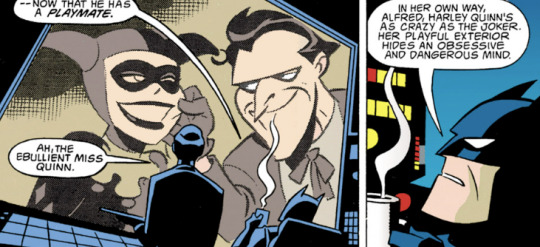
They are both characters who exhibit a behavior of wearing masks. For Harley it’s much more literal, unlike the joker who’s skin was bleached she puts on clown makeup and a mask. When she takes it off she could be any normal person, she even does so in the events of the origin comic herself to convince Batman of her innocence and lay a trap for him. Toga also, physically transforms but she started out hiding her quirk in front of nromals and appearing as a normal middle school girl.
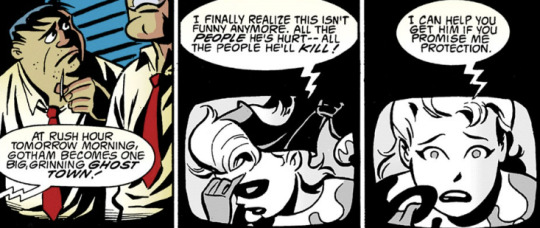
They are two characters who are seen as having two distinct selves, their normal original self, and the deviant villain they became, and most people around them can’t possibly understand how the girl they used to be had fallen so far. Except for them, there’s really not that much of a change.

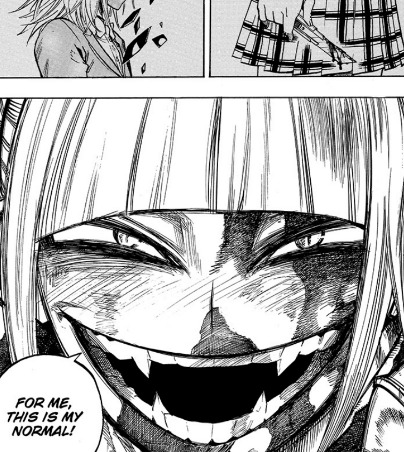
Harley and Toga are people who have always worn masks, so for them, the change from hero to villain is something as simple as changing the mask they wear. Curious the PLF member fighting against her asks how a girl could run away from a normal life and turned into such a mad monster, but for Toga this is her normal, this is the person she’s always been she simply stopped trying to hide it in front of others.
Of course as I said there’s another layer to this. Toga’s outright villain persona where she selfishly sucks the blood of people she loves and kills them, is yet another mask she wore. There are different sides of Toga depending on who she is interacting with, for all the bloodshed she’s capable of, she’s also capable of being a generally empathic and nurting person towards Twice. Twice even goes out of his way to say this to Hawks, that Toga isn’t the kind of person Hawks would think twice about killing, and yet Toga is a person who showed him kindness and understanding when no one else would.

Harley and Toga in their previous lives were lacking in something, something made them feel unloved and isolated to such extreme extents, that they were driven to snap and become someone else entirely in pursuit of that love they were missing. What is seen by everyone else around them as them descending into insanity, is actually just another mask they chose to wear. What’s seen as a total change in personality, is just an expression of who they are.
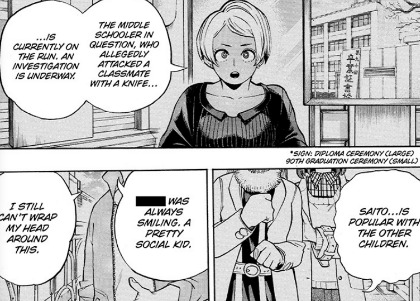
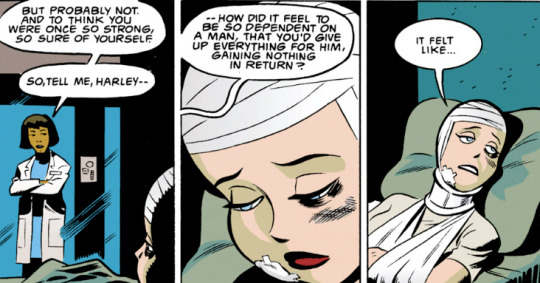
The strongest similarity between Harley and Toga is that they are both essentially chameleons, they are characters who continually change who they are in pursuit of love. Toga does this physically, her quirk involves her taking on the apperaance of anyone who’s blood she has sucked. Harley however, puts on a physical costume. Of all Batman Villains, Harley doesn’t make her own costume, rather she steals the identity and motif of the Joker the object of her affectsions. Just like Toga steals the appearance of those she loves, Harley puts on a costume that makes her a mirror image to the man she loves.
When Harleen Quinzel adopts the identity of Harley Quinn she is essentially becoming a mirror image to the joker. Batman even says, he doesn’t love anyone except maybe himself, and therefore what he sees of himself in her.
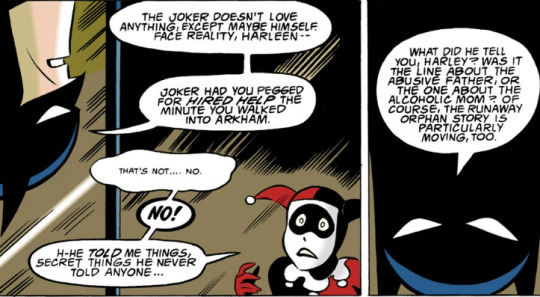
Of course, even after trying to take on their new identity in search of the love they found missing in their old lives, they both suffer just as much. Toga’s desire to be normal is undercut by her actions with the league of villains, because the more destruction she causes, the more she can’t be accepted by normal people like Ochaco. Toga dreams of becoming more like her, but she also finds herself rejected again, because Ochaco is not able to swallow some of the unsavory aspects of her personality, and the bodies she’s left behind her.
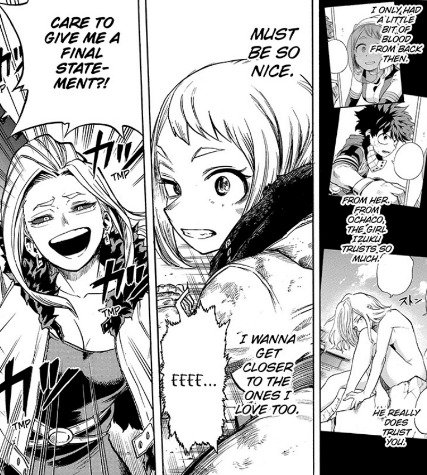
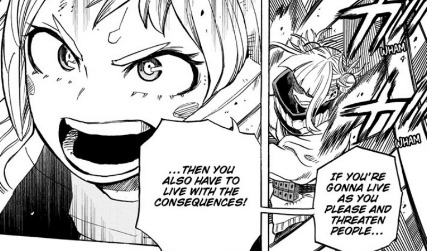

Toga created her mask to find acceptance with people, and for a time she did find it with the league, however with the league currently torn apart with the death of twice and AFO’s machinations, and her continued rejection by the heroes, the mask is now something that Toga cries underneath. She feels just as rejected as she did when she was a middle schooler, even though she became a villain in the first place to escape such a thing.
Harley suffers under her mask in a similiar tragic fashion, she ran away from her perviously life and changed everything about her identity to be loved, and finds herself continually abused and taken for granted by her lover. When she suffers that rejection again, it pushes her into further and further extremes as it does Toga.
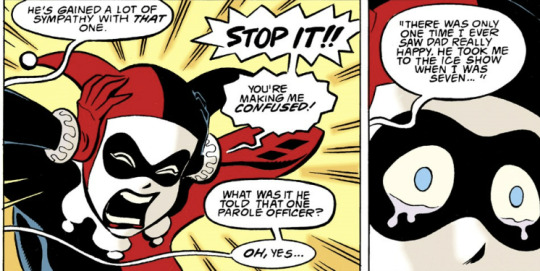
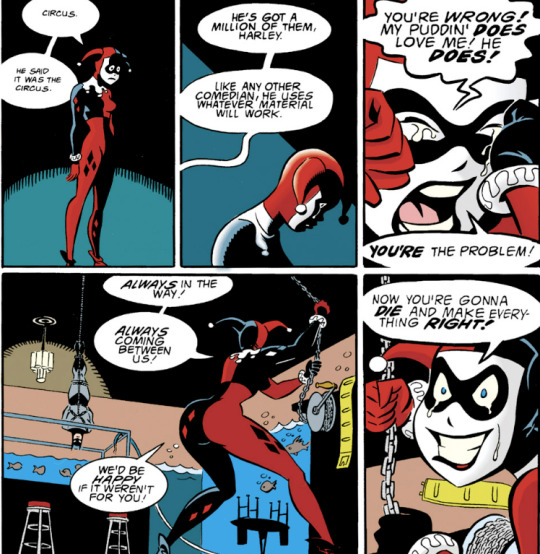

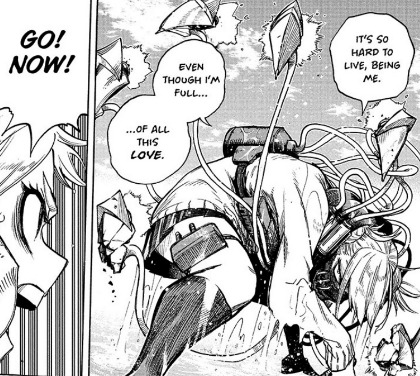
Toga after the death of Twice and rejection by Ochaco is at her lowest point yet, where beforehand she was willing to talk and looking to come to some sort of understanding between them, now she’s become her moth lethal and aggressive. Toga and Harley are both characters who center both their entire identity around loved and being loved, and also the pursuit of their goals around finding that love, and it’s behavior that causes them to crumble beneath the masks they wear to try to be loved. The more they change themselves in pursuit of love, the more unstable they get, and the reason why is because they probably weren’t even seeking love in the first place, but rather acceptance.
They changed themselves so much trying to be accepted, they forgot what they wanted was to be accepted for who they really were. That’s why, both characters deranged and violent as they may be are also truly tragic at heart (pardon the pun).
#himiko toga#harley quinn#mad love#mha meta#my hero academia meta#my hero academia#dc comics#comics meta#idk what to tag this#batman
68 notes
·
View notes
Note
Since it's obvious that deku is going to save shigaraki and it's very unlikely that Shigaraki's going to die: what are your hopes for the ending? the main theories I have seen are imprisoned (which? Doesn't seem that likely) or being adopted by all might and becoming a pro hero (which seems more likely? But I'd rather have the hero system not survive the manga)
Well, that's sort of two separate things: my hopes for the ending vs what will probably happen.
What I hope for is Shigaraki and the League pulling a karma houdini and running off into the sunset, never to get caught or serve time or pay for their crimes. That’s not to say they don't change - they stop being Villains out to destroy society, they're genuinely remorseful for the damage they've done, they make it up with self-assigned community service (vigilantism) for the rest of their lives. They run an orphanage that takes in the abandoned, the abused, the abnormal, and raise hundreds of children to be healthy, happy adults. Something like that.
I hope for this, because the series has not convinced me that much of anything has changed or will change so that what the League went through won't happen again, that the various failures of Hero Society will be corrected, that Heroes are doing anything substantial to prevent new Villains. A few Heroes here and there have finally approached a Villain and acknowledged that they're human and they have been wronged in some way - but they have not addressed at all the root causes.
The manga seems to believe that if only these Villains had been lucky enough to meet the one person who could've convinced them to endure the abuses, to not lash out, things would've been fine. If only Enji had gone to meet Touya and apologize - never mind the Hero ranking system that contributed to Enji’s toxic mindset, or the existence of the Himura clan who enabled a quirk marriage because they hated heteromorphs so much they would rather inbreed. If only Toga had met Ochako when she was younger - then she could've braved through quirk counseling and her parents emotionally abusing her. If only heteromorphs could've focused on good memories and be shining model minorities instead of being resentful - that’ll get those bigots who commit hate crimes against children to feel ashamed!
At the rate this is going, Deku vs Shigaraki will probably be something like this: If only there was a Deku-like person who was on the streets that day that Tenko was walking - then Tenko wouldn't have become justifiably resentful of the hundreds of other people who did ignore an injured five-year-old. If only he had a Deku-like friend who had magically appeared in the yard that night - then Tenko could've swallowed down his tears and smiled away the pain of his father’s abuse and family’s neglect.
If only a Deku-like Hero could’ve saved Tenko instead of All For One, then everything would’ve turned out okay - because it was AFO who entirely manufactured and introduced to Tenko the foreign, dangerous element of anger. It’s not as if being an orphan with a scary face (Jin), being known as the kid who killed his family/associated with having done something bad despite it being an accident (Gentle), having a strong quirk that people might fear (Toga), the possibility of being placed again in an dysfunctional/abusive home (Touya), the possibility of experiencing bullying because of all these things that make him stick out (Spinner, La Brava), and just having a lifelong tendency to empathize with and gravitate towards outcasts might just give him reasons to get frustrated and lash out at injustice still, even after his trauma was properly handled.
(Perhaps it’ll turn out that AFO gave Tenko the Decay quirk. How evil! We can thus blame everything on AFO and not have to examine the fact that, hey, regardless of how the quirk manifested, it exists and will affect the user’s life largely due to public perceptions of them and their quirk and whether they manage to behave in a way acceptable and in line with how people think someone with such a quirk should behave.)
It's true that sometimes, all it takes is the influence of one person, of a single act of kindness to change things. A single Hero to reach out and save someone in need. But is that not already the status quo in the story? We've got hundreds of Heroes patrolling the streets, ready to save someone; hundreds more students about to join them. We got one super-superman who spent 40 years pushing himself to his limits trying to be everywhere. All these individuals, all these acts of rescues, and still people had fallen through the cracks - which was also where the kindness stops.
What the story suggests is that Heroes should also reach through the cracks and help the fallen. That's a good start! Know what would be better? Fixing the cracks. Especially when those cracks aren't things Heroes can actually do anything about because it’s domestic violence behind closed doors, it’s gradual dehumanization through public and cultural institutions, it’s bigots beating children with shovels using no quirks and the excuse of generations-long communal superstition, it’s a system officially labeling people as Villain/Enemy like they're cartoony evil comic book antagonists to defeat instead of real people.
You might say, it’s obvious those things will be fixed! After the war. It’ll be dealt with! By a single panel in the epilogue. Yeah, fair enough. That’s also just bad writing. The conflict should be resolved within the story, the promise of change should be seen, not just vaguely told to us. I can't trust it.
What the League went through - discrimination, abuse, quirk counseling, marginalization, lack of social support, etc. - was injustice. If the new system that arises after this war - the one that will be led by Deku and his generation - does nothing or barely anything about these things, I cannot trust that the League going into this new system will be given true justice that take into account the crimes committed by them, but also the crimes committed by the people around them towards them and the failures created by the very structure of society.
I’m being very hard on the Heroes, I know, I’m expecting a lot out of them beyond just ‘saving hearts’. But canonically, Heroes are government-funded civil servants, and the Hero System is an important branch of the governance of this society. The responsibility - to all people - is theirs. If they cannot do this, then Heroes as they are should not exist; something different has to be implemented.
Shigaraki started this war against the world because it rejected him and his friends, it denied them a future where they could flourish as themselves. If the world changes, then he has a place to be. If the world does not change, then having him take a place in it is just forcing him to conform and keep enduring the same old injustices.
(But with a Hero friend this time. 🙂 Who shows him how cool Heroes are and teaches him to support the system again. 🙂 Who’s No. 1 in the rankings because competition and popularity has been kept… but it’s gentler or something now. 🙂 And who visits him in Tartarus 2.0, which is largely the same, complete with guns pointed at Shigaraki, just in case he ever uses his quirk because with that power he’s still too dangerous to take chances... but which is no longer staffed by wardens who call their charges ‘beasts in human skin’. 🙂)
The current trajectory of the story does not inspire me that things will change much. Kids wanna graduate from UA - so we gotta keep those Hero Schools! Business class students are filming everything for post-war propaganda! Gotta show how amazing and necessary Heroes are and continue their celebrity status! Wasn’t All Might so cool when he got into a mecha suit to beat up AFO and the whole world prayed for him? Gotta cement Heroism and belief in their righteousness into the collective consciousness and the dreams of humanity!
So I really want Shigaraki and the League to get to just run off and sentence themselves to what they think is appropriate penance. And if that’s sipping piña coladas on a beach somewhere, that’s what it is.
I apologize if I sounded harsh, anon! It’s not directed at you. My rant is just some of my frustrations with how the story has been progressing, and how either of those theories you’ve seen - imprisonment (likely in Tartarus 2.0) or being assimilated into the (same flawed) system - are lacking, in my opinion. My hopes for the ending are neither of those.
But my hopes are different from what I think is likely to happen. I actually think the opposite of what you think, anon: Imprisonment is more likely. I cannot see people in-universe and out (readers) accepting Shigaraki Tomura being adopted by All Might and becoming a Pro-Hero - it feels unrealistic for the civilian masses of a world that’s canonically wary of Shouto for being related to Dabi, a system that blames Aoyama for being a scared kid and request him to take responsibility for the cowardice of his parents, a moral lesson that says how heteromorphs react to brutal discrimination determines whether they should be listened to or not (and whether their children will be reasonably targeted in revenge); and too at odds with the sensibilities of most readers who are generally much less sympathetic towards the Villains than you and I am (and probably do want to keep the flashy Hero System. But make it ‘nicer’).
I’ve been browsing through Japanese message boards and the general theories I’ve seen actually include the possibility of death for Shigaraki - but it’ll be suicide, as penance for his crimes; or some convenient manner of dying that won’t dirty up Deku’s hands. Deku can offer him salvation for his heart and soul, but cannot forgive him and let him go unpunished. Shigaraki committed too much damage, too big a crime, and is too dangerous a person to be left alive. If he does survive, he should be imprisoned in Tartarus 2.0 for the rest of his life, and he can correctly show his remorse and rehabilitation by obediently following that sentence.
For a story that wants Shigaraki to be saved, to befriend Deku, to lose his anger and resentment and find hope in the future enough to assimilate back into a continuing Hero Society, I think the logical end result would be Shigaraki serving life sentence in Tartarus 2.0. maybe getting parole for good behavior when he’s 50 and not as sprightly enough to be as deadly a threat.
Mostly, though, I try not to predict the ending, beyond a small vague hope of Ultimate Karma Houdini I keep at the very back of my mind. Save myself from any disappointment! I remain in the present and accept chapters as they come.
#ask#asked#answered#anon#anonymous#Thanks for the ask!#sorry if I'm depressing#nalslastworkingbraincell#Shigaraki Tomura
27 notes
·
View notes
Text
The Unseen Sleigh: Mental Health Struggles This Holiday Season
The holiday season, widely regarded as a time of joy and celebration, is not always the happiest time of the year for everyone. While festive decorations adorn streets and families gather, some silently grapple with inner demons, finding themselves ensnared in the clutches of mental health challenges. Recognizing the signs that a friend, family member, or even oneself may be struggling is crucial in fostering a supportive environment during this supposedly cheerful time.
There are subtle signals that someone close to you may be grappling with their mental well-being. A sudden withdrawal from social activities, changes in sleep patterns, or a noticeable decline in personal hygiene can be indicators of internal struggles. Additionally, expressions of hopelessness, constant fatigue, or a marked change in appetite should not be dismissed lightly. Recognizing these signs requires a heightened sensitivity to the nuances of behavior and a willingness to engage in meaningful conversations.
Approaching someone who might be struggling with their mental health requires a delicate touch and genuine concern. Instead of immediately delving into their emotional state, initiate a conversation with casual inquiries about their well-being. Creating a safe and non-judgmental space allows individuals to open up at their own pace. Phrasing questions with empathy, such as "I've noticed some changes, and I'm here for you," can encourage a more open dialogue.
Active listening plays a pivotal role in these conversations. Give your full attention, refrain from interrupting, and express empathy without offering immediate solutions. Encourage them to share their thoughts and feelings, and reassure them that seeking help is a sign of strength, not weakness. It's essential to respect their autonomy and decisions while gently encouraging professional assistance.
In times of mental health crises, seeking help is paramount. Fortunately, there are resources available to guide individuals toward support and recovery. Mental health hotlines, community counseling services, and online therapy platforms offer accessible avenues for those in need. Encourage your loved ones to explore these resources, emphasizing that seeking help is a proactive step toward healing.
Let us all be mindful that the holiday season is not universally a time of unbridled joy. It is our collective responsibility to be attuned to the struggles that may be hidden beneath the surface and to extend a compassionate hand to those who need it.
Please endeavor to prioritize mental health in our conversations and interactions. Break the stigma surrounding mental health issues by fostering an environment where openness is valued. Reach out to friends and family, asking not just about their holiday plans, but also about their well-being. A simple, genuine inquiry can make a world of difference.
For those who may be struggling or for those who want to support someone in need, there are resources available:
United States
Chat anonymously with an Active Listener: 7 Cups of Tea
Live Chats: Lifeline Chat (24/7) or imalive.org
National Eating Disorders Association or 1–800–931–2237
S.A.F.E. Alternatives for Stopping Self Abuse or 1–800-DONT-CUT (366–8288)
National Suicide and Crisis Lifeline or dial 988 or (en Espanol)
The Trevor Project (LGBT crisis intervention) or 1-866-488-7386
Rape Abuse & Incest National Network or 800-656-HOPE (4673)
Australia
Lifeline Australia or 13 11 14
beyondblue or 1300 22 4939
Suicide Call Back Service or 1300 659 467
Brazil
CVV or 141
Chile
Teléfono de la Esperanza or (00 56 42) 22 12 00
France
S.O.S Amitié
Germany
Telefonseelsorge or 0800 111 0 111 (or 222)
Greece
KLIMAKA Center for Suicide Prevention 1018
Japan
TELL Lifeline chat in English/Japanese or 03-5774-0992 (English)
Poland
116 111 - Free crisis helpline for children and young people, available 24/7
116 123 - Toll-free crisis helpline for adults, 2-10pm 7 days per week
800 70 2222 - Free direct support line for people in a state of mental crisis, available 24/7
Portugal
SOS VOZ AMIGA - contacts:
21 354 4545
91 280 2669
96 352 4660
Sexual Abuse Intervention - 808 222 003
Portuguese Victim Support Association 116 006
Spain
Teléfono de la Esperanza or 902500002
UK
The Samaritans or 08457 90 90 90
Other countries
7 Cups of Tea - find your country in the drop-down menu
Befrienders Worldwide - find your country in the drop-down menu on the top right
International Association for Suicide Prevention - find your nearest crisis center
Unsuicide - online suicide help directory
5 notes
·
View notes
Text
McKinsey and Providence colluded to force poor patients into destitution

Providence is a health giant whose anchor is a network of Catholic hospitals. They colluded with McKinsey to steal from their poorest patients, by deceiving them about their eligibility for free care, saddling poor, sick people with crushing debts:
https://www.nytimes.com/2022/09/24/business/nonprofit-hospitals-poor-patients.html
Though Providence is nominally a nonprofit, but it sits atop a $10 billion private equity fund that it invests in unrelated sectors. Its nonprofit status lets it evade $1.2 billion per year in federal and state taxes. The company stole $500,000,000 in US covid relief intended for hospitals in danger of closure. Its CEO makes $10,000,000 per year.
As a nonprofit, Providence is required to provide free care to low-income patients. In 2018, the company retained the services of McKinsey and Co, a scandal-haunted global consulting firm with a long track record of designing criminal strategies for its clients. There are many ghastly examples of this conduct — for example, helping the Saudi government hunt down, torture and murder dissidents:
https://www.nytimes.com/2018/10/22/business/dealbook/mckinsey-saudi-dissidents.html
Closer to home, McKinsey crafted ICE’s immigration sweeps and helped design the notorious kids-in-cages detention centers, counselling the Trump administration to control costs by denying detainees adequate food and health care:
https://www.propublica.org/article/how-mckinsey-helped-the-trump-administration-implement-its-immigration-policies
(McKinsey then lied about this)
https://www.propublica.org/article/mckinsey-called-our-story-about-its-ice-contract-false-its-not
All these failures and scandals are even more infuriating when you learn about McKinsey’s internal mythologizing. The company tells new recruits that they are a global force for good, comparing their consulting work to the Catholic Church and the US Marine Corps.
https://www.propublica.org/article/how-mckinsey-makes-its-own-rules
This is an obviously absurd claim — no matter how many people McKinsey helps murder, they’ll never come close to either institution’s body-count. But McKinsey has a comprehensive plan to sell this image to its “associates,” starting with a curriculum to help very young children learn to act like McKinsey consultants:
https://pluralistic.net/2022/02/15/management-jesuits/#pmc-jr
But a recurring motif in the long symphony of McKinsey scandals are those involving health-care. They made $100,000,000 in failed, idiotic, bumbling covid initiatives:
https://pluralistic.net/2020/07/15/3-frauds-in-a-trenchcoat/#failing-up
They designed Big Pharma’s price-gouging program:
https://pluralistic.net/2021/11/25/strikesgiving/#cool-story-pharma-bro
They helped the Sacklers — a multigeneration crime family of pharma billionaires whose Oxycontin set off the opioid epidemic — design their sales program, suggesting that pharma distributors be paid cash bounties for each fatal opioid overdose in their sales territory:
https://www.nytimes.com/2021/02/03/business/mckinsey-opioids-settlement.html
They helped pharma companies design programs to convince doctors to overprescribe opiods:
https://pluralistic.net/2022/06/30/mckinsey-mafia/#everybody-must-get-stoned
Then, after the Sacklers declared their pharma company bankrupt, protecting their billions from their victims, McKinsey helped craft their bankruptcy strategy, ensuring that they could vaporize their victims’ claims while holding onto their fortune:
https://pluralistic.net/2021/07/29/impunity-corrodes/#morally-bankrupt
As all this was coming to light, a senior McKinsey specialist drafted a plan to hide the company’s role in the opioid crisis, illegally destroying internal memos relating to litigation:
https://www.nytimes.com/2020/11/27/business/mckinsey-purdue-oxycontin-opioids.html
In light of all this, it’s only natural that Providence would turn to McKinsey when they needed help committing crimes and destroying thousands of people’s lives. McKinsey helped Providence craft a program to coerce poor people into paying for care they were entitled to get for free. They called it “Rev-Up.”
Writing in the New York Times, Jessica Silver-Greenberg and Katie Thomas reveal the full depravity of “Rev-Up.” McKinsey advised Providence to train its staff to avoid truthfully answer poor patients’ queries about whether they were eligible for free care.
https://www.nytimes.com/2022/09/24/business/nonprofit-hospitals-poor-patients.html
When patients asked if they were eligible for free care, Providence employees were trained to answer “Payment is expected.” Staff were told “Don’t accept the first ‘no.’” Rather, they were told to reply, “How would you like to pay for that today?” If patients still pressed them on their legal entitlement to free care, Providence employees were told to ask if the patients’ employers would pay for half their care.
When patients asked why a nonprofit hospital was asking them to pay more than they could afford, reps were counseled to reply, “We are a nonprofit. However, we want to inform our patients of their balances as soon as possible and help the hospital invest in patient care by reducing billing costs.”
After saying this, reps were supposed to add, “how would you like to take care of this today?”
If patients continued to press Providence reps on their eligibility for free care, then, finally, could the reps discuss the hospital’s legal obligation to wipe out the bills for those in need.
Charity care costs the average US nonprofit hospital 2% of its total expenses. For Providence, it’s less than 1%. In 2018, when the company hired McKinsey to design Rev-Up, it was 1.24%.
In pursuing a <1% reduction of expenses, the “nonprofit” ruined the lives of thousands of poor people, including its own employees, who are so badly paid that they qualify for free care. The Times quotes Bev Kolpin, a Providence Oregon sonogram tech who paid her own employer $8,000 to have a cyst removed (she had to take unpaid leave for the procedure).
Michael Hudson tells us that “debts that can’t be paid, won’t be paid.” Poor people can’t afford to pay the sticker price of care at Providence, so Providence sent thuggish collection agencies to hound patients (including Medicaid patients) to pay the balances that should have never been assessed.
The Times spoke to patients who were taken to collections by Providence and thereafter avoided seeking care for themselves and their children, even for urgent conditions. Dean A. Zerb, a former congressional staffer who investigated nonprofit hospitals, said “That is the outcome that hospitals like Providence may be hoping for.”
One of the most haunting details in the Times report is the story of Vanessa Weller, a single mother in Alaska, who delivered a premature baby at the Providence Alaska Medical Center. The baby died five days later, but Weller was pursued for $125,000 in medical bills by Providence. As a manager at a local Wendy’s, she was entitled to have her bill erased. Instead, she was relentlessly chased by bill-collectors and her credit rating fell from 650 to 400.
Providence professes to be shocked, shocked that all this happened. Providence CFO Gregory Hoffman told the Times that the news that his company had failed in its legal obligations after paying a consultant to teach them how to do this “very concerning,” adding that these victimized patients “have our attention.” McKinsey made at least $45,000,000 for designing Rev-Up.
I have my own experience with Providence, though not nearly so disturbing. In 2018, my parents came to stay with me in Burbank. My father fell gravely ill — he had kidney stones and a septic bladder infection. He went to the local Providence ER and nearly died. He was in a coma for two days. As my mother stood at his bed-side, not knowing if he would live out the day, a billing agent for the hospital came into the room and began to pester her about how she would pay his bill.
Thankfully, my parents are retired, unionized schoolteachers from Canada, and they were fully insured. But insured or not, it was such a disgusting, filthy, callous thing to do that I have never forgotten it. Thankfully, my father made a full recovery but I have no interest in ever visiting a Providence hospital
[Image ID: A collage. On the left is an image of a cigar-chomping plutocrat in a top hat. He stands at a control box whose lever is fashioned into a dollar-sign. The control box bears the logo of McKinsey and Company. In one gloved hand, he holds aloft a sad, cloth-capped young man on crutches. On the right is an ogrish thug wielding a club and holding out his free hand in a 'gimme' gesture. He wears a doctor's reflector around his head. Behind them is a hospital ward. On the wall of the hospital ward is the logo for Providence hospitals.]
58 notes
·
View notes